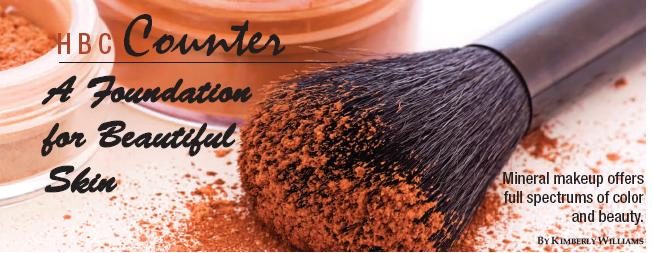Over the past decade, there has been growing interest in mineral makeup. These cosmetics are not completely brand new to the industry as some may think; it has roots dating back to the mid-1970s. Suffice it to say that mineral makeup has garnered public acclaim because it is au naturale, while still offering variety. With that, there are several forms of mineral cosmetics on the market including bronzer, foundation, blush, concealer and eye shadow.
Getting the Most from Mineral Makeup
Mineral makeup is made from overlapping microscopic crystals. It is not irritating because it allows the skin to breathe as it should. It is made with naturally colored minerals and pigments, thereby eliminating the use of chemicals, harsh dyes, preservatives or by-products, which are staples of traditional makeup (1). It also is water resistant, rarely requires touching up once applied and is said not to crease or smear. And, it is concentrated, which means that only a little is needed to achieve a desired look.
 Mineral makeup is preferred by some women over leading traditional brands because it doesn’t cause allergies, clogged pores, skin sensitivities, hormonal problems and is especially useful for those who could not otherwise wear makeup on their sensitive skin (2).
Mineral makeup is preferred by some women over leading traditional brands because it doesn’t cause allergies, clogged pores, skin sensitivities, hormonal problems and is especially useful for those who could not otherwise wear makeup on their sensitive skin (2).
According to dermatologist Francesca Fusco, assistant clinical professor of dermatology at Mt. Sinai Medical Center in New York, NY, “It’s non-comedongenic, so it won’t clog pores, and it’s not going to aggravate an acne condition or cause a flare-up as easily as some traditional makeups can” (1).
Adding to its plethora of benefits is the fact that certain forms may have a calming effect on the skin. This proves to be especially useful for those who suffer from rosacea (reddening of the skin) or acne (1). Researchers also believe mineral makeup offers significant protection from the sun thanks to its key SPF ingredients (titanium dioxide and zinc oxide).
A Colorful Makeup
Is there more than one type of mineral makeup? You bet. There are actually two different types on the market: those that are not made from synthetics and those that do not include fillers, colors, fragrances, binders, preservatives and chemicals (2). So, be sure you are stocking your shelves with all-natural makeup and ask your vendor for clarification before purchasing such products for your store.
On the natural makeup front, customers should know that it is primarily made from four or five key ingredients. Below are a handful of the most common minerals used in makeup:
• Titanium dioxide is a natural sunscreen and anti-inflammatory agent containing particles that are not easily absorbed by the skin.
• Mica is shimmery and helps cover up blemishes.
• Iron oxide is used to produce skin tone pigment. It is most known for its non-toxic, moisture-resistant and non-bleeding properties.
• Zinc oxide is commonly used as a sunscreen as well as for the treatment of skin conditions, namely eczema and psoriasis.
• Ultramarine pigments are taken from limestone and some contain the blue mineral lazurite (lapis lazuli) (3).
Natural mineral makeups usually are formulated without bismuth oxychloride, talc, dyes and parabens.
Consumers Weigh-In on Mineral Makeup
How does mineral makeup fare with women? A U.S. Color Cosmetics report by Mintel, a market research firm based in Chicago, IL, shows most women are not aware of the benefits mineral makeup may offer. One consumer research survey shows that one in three women in the United States believes mineral makeup is “better for their skin” than traditional options. In contrast, far fewer women use mineral products, with one in 10 claiming to use them on a daily basis (2).
Why? Perhaps retailers do not offer mineral makeup or stores do not have a variety to choose from. It’s also likely that stores may not offer enough education about the benefits of mineral makeup. The fact is retailers can greatly increase their bottom line by sharing their knowledge of mineral makeup with shoppers and staff, particularly given that many consumers who do understand this category are snatching up mineral cosmetics by the score. Market research shows that the global color cosmetics industry is worth $35.7 billion. The mineral-based makeup category is a key part of this business, and has a “predicted annual market growth of 3% until the year 2011” (4). One mainstream mineral makeup company reported net sales for the third quarter of fiscal 2009 of $135.7 million, which was an increase of 4% from $130.2 million, during the same period in 2008 (5).
Who Are My Key Customers for Mineral Makeup?
According to an online survey administered by The Benchmarking Company, women ages 18 to 50 and older are likely to purchase mineral makeup (6). Thus, your store’s makeup display should be as diverse as your customers’ age ranges and unique needs. Mineral makeup offerings should include everything from the season’s most talked about shades to the calmest hues and everything in between. WF
References
1. C. Bouchez, “The Lowdown on Mineral Makeup,” www.webmd.com/health-ehome-9/mineral-makeup, accessed November 11, 2009.
2. I. Matthews, “Mineral Make-up: The Natural Alternative,” www.specialchem4cosmetics.com/services/editorials.aspx?id=2725, accessed November 11, 2009.
3. S. Strausfogel, “Mineral Magic: Is it Skin Care or Makeup,” Better Nutrition, May 2007.
4. S. Pitman, “Mineral Make-Up Brand Aims for Global Reach,” www.cosmeticsdesign.com/Products-Markets/Mineral-make-up-brand-aims-for-global-reach, accessed November 12, 2009.
5. Bare Escentuals Beauty, Inc., “Bare Escentuals, Inc. Reports Third Quarter Fiscal 2009 Results,” http://ir.bareescentuals.com/releasedetail.cfm?ReleaseID=419999, accessed November 12, 2009.
6. The Benchmarking Company, The Pink Report: Age of Naturals,
www.benchmarkingco.com/downloads/AON012008.pdf, accessed November 12, 2009.
Published in WholeFoods Magazine, Jan. 2010









